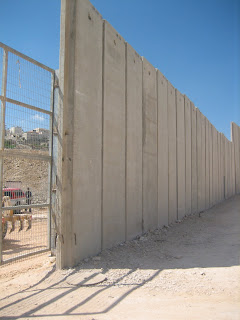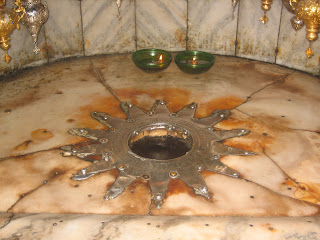 Us being denied access to an area of our tour. The wall has just recently went up. Residents on the inside of the wall have been given a key to unlock a gate so that they can go in and out as they please. But, when a resident came to let us in, he was denied access. It was a clear violation of his rights - none the less he was not grated them.
Us being denied access to an area of our tour. The wall has just recently went up. Residents on the inside of the wall have been given a key to unlock a gate so that they can go in and out as they please. But, when a resident came to let us in, he was denied access. It was a clear violation of his rights - none the less he was not grated them. A street in the Old City.
A street in the Old City. The Wall.
The Wall. Bethany at the crucifix.
Bethany at the crucifix. The three men on the right were evicted from their homes, on the left is our tour guide, Rotem.
The three men on the right were evicted from their homes, on the left is our tour guide, Rotem.Loooonnnggg entry…
Today was an important day, not because Madonna visited the Western Wall in the Old City to pray (I was there just a few hours before her!), but because we were given insight to current sources of conflict. Much has been said about Israeli settlements, but I never understood the concept of them until we took a tour with The Israeli Committee Against House Demolitions (ICAHD).
While I thought I had a pretty good understanding the differences between Israel and West Bank and the Israeli Defense Force’s (IDF) occupation of Palestinian territories, it is clear to me that it is much more complex than I originally anticipated.
Originally we started to commute around Palestine, I was confused by the location of the checkpoints. There is checkpoint operated by the IDF to get from Bethlehem to East Jerusalem, both cities within the borders of the West Bank along with numerous checkpoints that block Palestinian territory from Palestinian territory. The reason for this is because Israel has slowly since 1967 occupied territory between the Green Line (the border established after the 6-day war in 1967) and the location of the checkpoints in order to secure more land for Jews.
Going through checkpoints can be incredibly difficult for Palestinians as they must have a work permit in order to go across the border freely. If they do not possess such a permit, they must apply for one (and pay for one – sometimes NIS 1000 or about $380USD) in order to cross the border for a day. For people who have chronic health problems that require the expertise of someone practicing on the other side of a checkpoint, this can become very expensive and hazardous to their health.
While having a work permit means that a Palestinian has an opportunity to work in an industrialized country, checkpoints pose significant obstacles. Workers typically start lining up at 3am in order to ensure that they get through a checkpoint and arrive to work on time. Some with work permits have moved to East Jerusalem (Palestinian area of Jerusalem), but rent there is about 3 times higher than in Palestine. The wall has also produced a great deal of unemployment (this is from the literature I received today and may vary from what I have previously mentioned): 50% in the West Bank and 80% in Gaza.
We began our tour with a brief overview of recent history in Israel, showing the moving lines from 1948 and on. Then we met three brothers (pictured) living in Jerusalem who had recently lost their homes due to an Israeli eviction. All three men, in their 50s, had been born in those homes and they were built as compensation for being displaced after the war in 1948. The homes were in Jordanian territory until 1967 when Jerusalem was split and the home now was a part of West Jerusalem (Israeli territory). After this change over, Israel, claimed ownership of the land and in an attempt to make West Jerusalem more “Jewish”, the Palestinian families, along with 58 others were evicted from their homes on the grounds of not paying an Israeli settlement organization rent for a home they owned. In the middle of the night IDF soldiers surrounded the home and the families were given 20 minutes to collect their things and leave. The women weren’t even given time to put on headscarves. The IDF issued the family a tent to live in. Period. This eviction caused such an uproar that Hilary Clinton commented and Jimmy Carter paid the families a visit. Currently the family is homeless and has set up camp across the street from their former home. Hours after everything was emptied from the home, Israeli settlers moved in.
Many evictions and home demolitions have happened this way. Because of a culture where documenting ownership of land prior to 1948 when many people received compensation from then-controlling governments, Israel claims ownership of these lands because Palestinians were never given proper documentation.
While evictions and home demolitions are taking place in existing homes, the notion of settlers has reached a new level. Since the 70s, the Israeli government has been creating settlements in Palestinian territories. These settlements violate the agreed-upon boundaries established in the 1967 agreement. They have since been adjusted in Peace agreements in Oslo and at Camp David, which now allocates these areas to Israel. While all may seem fine and dandy now, the land was unlawfully seized by Israelis from Palestinians and they have adjusted boundaries as they see fit afterwards. Also, in an attempt to maintain US support, Israel has hired 10 American public relations firms to lobby media companies to show Israel in a good light. An example would be that Israeli settlements are often referred to as “neighborhoods” so that any conflict can appear to be unprovoked by Israelis.
A question you may have is why would any Israeli agree to live in a settlement in the middle of Palestinian territory or move into a home that a Palestinian was evicted from (especially one that generated enough media attention that both Hilary Clinton and Jimmy Carter felt compelled enough to personally comment on)? It’s important to understand that there are two kinds of settlers: economic and ideological. Currently there are 450,000 settlers living in the West Bank, and most settlements have around 30,000 people in them.
Economic settlers live in settlements for, you guessed it, economic reasons. Despite popular belief, Jerusalem is the poorest city in Israel. Settlements are a huge attraction for people living at the margins because the Israeli government subsidizes nearly everything: rent, education, healthcare, etc. Also, some are located close to industrial areas, making it easy to access quality work. Living in a settlement is a nice alternative to the poorer areas of Jerusalem.
Ideological settlers are the scarier alternative. They believe that living in Israel is their right and Palestinians are intruding on their God-given right. In Hebron, a southern Palestinian town, nearby settlers have terrorized Palestinians. They destroy farmland, throw stones at Palestinian children as they walk to school, and harass the neighborhood so that many are afraid to come out of their homes.
We drove into a settlement towards the end of our tour and I found them to be quite, for a lack of better word, unsettling. The settlement looked like something straight out of the pages of Pleasantville or Beverly Hills. The grass was incredibly green; the streets were lined with Palm trees. The flats were clean, every roundabout was landscaped, and the pools were filled with children on a hot day. While it sounds like a nice neighborhood, it is in the middle of a desert. Water is already a precious resource for the area. Palestinians comprise of 33% of Israel/Palestine’s population, but receive 10% of the water. Clearly the settlements are receiving a disproportionate amount of water as they have pools and greenery. The boundaries dictated by the wall have been strategically placed around aquifers, giving Palestine no control over water; it is also illegal for them to build wells leaving them at the mercy of Israel for this resource.
There has been a great deal of talk about solutions for Israel/Palestine. Many (including President Obama) support a two-state solution. Presently, however, current Palestinian territory is completely separated from each other, not only between Gaza and the West Bank, but parts of the West Bank are completely separated from one another. Logistically, this would be even more of a headache as it would require the relocation of Gaza’s residents and Arabs living outside Palestinian territories (around 250,000 total), plus it would require Israel to give up territory to reconnect the West Bank – unlikely.
After today, I’m finding that the current situation in Israel/Palestine has a chilling resemblance to my study abroad alma mater, South Africa. A group of people is being aggressed by a dominant force. Palestinians are restricted from moving in their own country and they have no voting rights to choose leaders that impose these restrictions on them. The stories of rejected permits in Israel/Palestine remind me of the papers blacks were required to carry to move about their own country. Palestinians, like black South Africans are subject to economic development restrictions in the name of security. Unfortunately this situation only seems to be getting worse before it gets better and sadly there are very few people engaged in the happenings of the country. Americans commonly are accused of being misinformed about the issues their own countries face – the same is true of Israelis, very little understand what their government is doing and simply see Palestinians as unruly.
Well, that’s enough for this evening. Please let me know if you have questions – I would be happy to answer them. I love, love, love the comments!!
Also, I have received my address and cell phone number (you can call from Skype for two and a half cents a minutes). Please message or e-mail (blan0196@umn.edu) if you wish to receive either.
Special thanks to:
Rotem, our very knowledgeable tour guide
Dad, for a good phone conversation
Marc Broussard, for accompanying me through song as I write
 T
T


